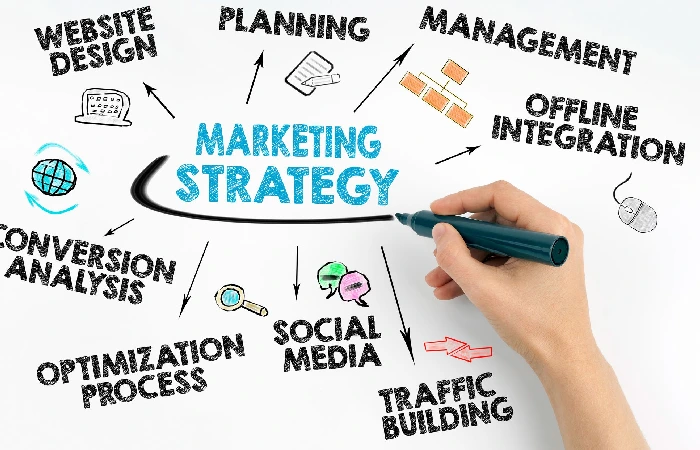Definition of Market Strategy
A market division strategy classifies your customer or business file by demographics, geography, behavior, psychographics, or a combination. Market division is a strategy to divide a target audience into smaller, more nearby groups.
A good market strategy is one of the most important keys to the success of companies that manage to reach their target spectators and offer solutions to their wants. In this article, we will present what it consists of, its advantages, and strategies you can develop to achieve your business goals.
What is a Market Strategy?

A market strategy is a company’s plan to reach possible consumers and convert them into customers of its products or services. The market strategy contains long-term planning of the company’s objectives.
To achieve these commercial objectives, it is essential to sensibly select the specific actions that will allow the alliance of the brand image and the reputation of the products and services to increase sales in the market.
Elements of a Market Strategy
The elements of a marketing strategy that you must reflect on to thrive are:
Product
A product is a good or service a company offers its customers. To be successful, marketers must appreciate the life cycle of a product and have a plan to guide products to finish each stage of the process.
The nature of the product also partly controls how much companies can charge for it, where they should home it, and how they should market it.
Price Fixing
Causal the price of a product, that is, the cost that customers pay for it, is one of the most essential tasks of a marketing strategy.
Marketers must relay the price to the actual and apparent value of the product but must also consider shipping costs, periodic discounts, and player prices.
Placement
When a company makes placement choices, it tries to determine where to sell a product and how to launch it.
In a marketing strategy, assignment means placing products exactly where they will be seen by consumers who will most likely buy them.
For example, you could place a creation in a specific window in a store, but you could also put the produce in a TV series, movie, or website to draw devotion to the product.
Financial Support
In a marketing strategy, publicity includes advertising, public relations, and any activity linked to disseminating a product or service to the public.
Product promotion aims to show the target spectators why this product is suitable for them, how it suits their wants, and why they should buy it.
Marketers tend to combine the elements of advertising and placement to reach their core audience.
Benefits of Developing a Market Strategy
As you can imagine, developing a marketing strategy can have several benefits for a business, including:
1. Increased Audience and Sales
With an effective marketing strategy, you can reach a vast audience through social media, search engine optimization, paid ads, YouTube, etc.
When good marketing tactics are used, more sales are achieved. It’s not just about attracting new customers. Still, a well-thought-out marketing strategy will also build loyalty from existing and previous customers and even make them buy higher quality products every time.
2. Improve Brand Reputation
The marketing strategy also implies that the public knows your values, culture, and the purpose of your business or company. When you can communicate these things, you create brand awareness.
Your company’s brand is essential. Your reputation will improve through online marketing and advertising, transparency, customer retention, and intelligent tactics.
Building your brand status is one of the benefits of marketing that small businesses overlook or dismiss.
Today’s consumers tend to do extensive research on all the products and services they want to buy, so branding is more important than ever.
A good reputation leads to a higher level of trust from our clients and target audience, attracting better talent to the team and more benefits.
3. Inform Your Target Group
A good marketing strategy will help you obtain data and metrics to find your audience and get to know them healthily, so you can better target your efforts.
Accessing detailed information about your customers is key to offering effective products and services that provide a competitive advantage in the marketplace.
The collected data provides deep insights into your customers. Including their online activities, purchasing behavior, and interactions with stores and merchants.
A customer data-driven marketing strategy is one of the best ways to develop various revenue torrents from segmented audiences.
Once you have a compact understanding of your target audience. You can target them in a way that meets their specific needs and pain points.
4. Win the Trust of Customers
Trust is essential when doing business. So take advantage of all the reasons consumers can trust you and reinforce those signs of trust.
In short, when analyzing the benefits of a marketing strategy. Increasing customer confidence is one of the most valuable indicators since it is like a perpetual motion machine that feeds itself while generating what it wants. I have to.
5. Increase Return on Investment
When you understand how to engage with consumers more effectively. You’ll be able to create campaigns that are as unique as your consumers.
By intentionally reaching real people who are likely to respond to specific outlets and have particular interests, your people-based marketing strategy can increase conversions, sales, and, therefore, your overall return.
Types of Market Strategies

Now that you know a slight more about the importance and benefits of developing a planned marketing strategy. We present seven types of techniques that you can put into practice:
Segmentation Marketing Strategy
A market division strategy organizes your customer or business folder by demographics, geography, behavior, psychographics, or a combination. Market division is a strategy to divide a target audience into lesser, more handy groups. In general, there are forms of segmentation, such as:
They are differentiated In targeting each market segment with a different offer and positioning.
Undifferentiated: When segments with different needs are identified. But the company targets them with the same offer to try to capture the most significant possible number of customers.
They are focused: When only one of the market segments is selected.
Marketing Strategy for Brand Positioning
The brand positioning strategy consists of finding a place for a brand in the market and in the consumer’s mind. The aim is for the target group to be able to consciously or unconsciously assist a longing or need with the brand.
If the brand does not do this. It becomes another product or commodity on the supermarket or mall shelf. This strategy defines how the brand wants to be perceived in the selected strategic segments and what characteristics we want to have as a company or brand in the consumer’s mind.
There are several ways to position yourself against the competition. Be it with the product’s cover, the company’s image, or the product’s characteristics and uses.
Covert Marketing
Covert marketing, or stealth marketing. Is a strategy in which a companies markets its product subtly and hides behind other content. Such as news or an event.
That is, it is the strategy of presenting a product to consumers in a way that does not look like an advertisement. So this marketing strategy focuses on marketing the product. At the same time, customers are unaware of the system behind it.
Loyalty Marketing Strategy
The marketing or loyalty marketing strategy aims to maintain customer loyalty and prevent them from being left behind by the competition. Thanks to the constant creativity and good customer service that the company offers its consumers.
This strategy can include discounts, promotions, giveaways, community brand marketing, etc. To increase sales opportunities and motivate the target audience to buy the promoted products.
Content of Marketing Strategy
Content marketing is a strategic method that focuses on creating and distributing relevant and consistent value. The content should attract and retain addressees and drive them to change one step at a period.
This strategy is based on creating content such as articles, infographics, electronic books, white papers, informative videos, etc.
Digital Marketing Strategy

A digital marketing strategy involves evaluating specific goals that can be achieve through online channels.
It can be Composed of the Following:
Inbound Marketing: Used to appeal to and convert customers through helpful content organically.
E-mail marketing: Here, you can build segmented communication.
Social Networks: To connect your networks with clients and web search engines. So that the brand appears in the first options, among other things.
SEO Strategy
An SEO positioning strategy is organizing a website’s content by topic to improve the probability of appearing in search results.
An SEO-focused marketing strategy agrees you to exploit organic traffic to your website from Net search engines.
Conclusion
As you can see, a well-executed marketing strategy can make you more outstanding. More accessible when customers need what you’re selling. And more visible when people want to know more about what you do.
Also Read: Customer Analysis – The Complete Guide to Effective Customer



